全新英语语法——状语从句
英语语法讲解状语从句
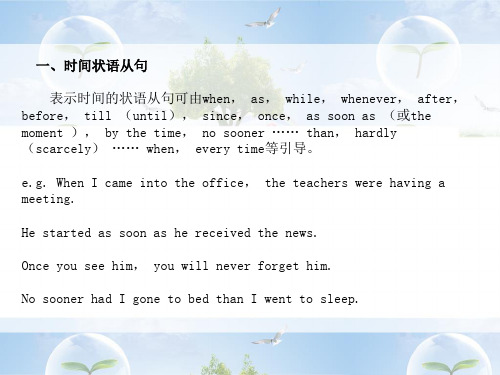
Whatever ( = No matter what ) you say, I'll never change my mind.
八、方式状语从句
方式状语从句常由as, as if (though), the way, rather than 等引导。
You can go swimming on condition that ( = if ) you don't go too far away from the river bank.
If he had come a few minutes earlier, he could have seen her.
e.g. He is disappointed because he didn't get the position.
As it is raining, I will not go out.
Now that you mention it, I do remember.
三、地点状语从句
引导地点状语从句的连词是where 和wherever等。 e.g. Sit wherever you like. Make a mark where you have a question.
一、时间状语从句
表示时间的状语从句可由when, as, while, whenever, after, before, till (until), since, once, as soon as (或the moment ), by the time, no sooner …… than, hardly (scarcely) …… when, every time等引导。
英语语法:状语从句归纳整理
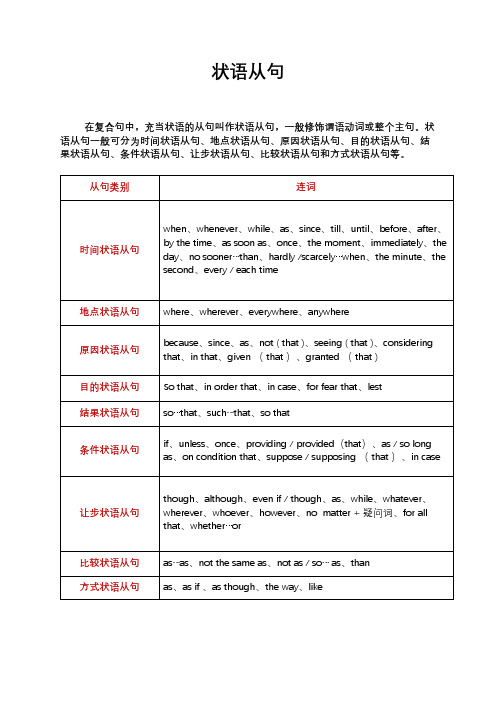
状语从句在复合句中,充当状语的从句叫作状语从句,一般修饰谓语动词或整个主句。
状语从句一般可分为时间状语从句、地点状语从句、原因状语从句、目的状语从句、结果状语从句、条件状语从句、让步状语从句、比较状语从句和方式状语从句等。
一、时间状语从句在复合句中起时间状语作用的从句称为时间状语从句,可放在句首、句中或句尾。
(二)until 和 till的用法1.肯定句:主句的谓语动词必须是延续性动词,主句、从句都为肯定式,意为“直到……为止”;2.否定句:主句的谓语动词必须是非延续性动词,从句为肯定式,表示“某动作直到某时才开始”;3.till 不可以置于句首,而until可以。
例:They waited till / until I returned.他们一直在等我回来。
You may stay here until / till the rain stops.你可以待在这里直到雨停。
He won’t go to bed until / till she returns.直到她回来,他才上床睡觉。
Until you told me I had no idea of it.直到你告诉我,我才知道这件事。
(三)since的用法(四)before的用法一般情况下before表示“在……之前”,有时根据上下文,还可表示“还未……就……” “不到……就……” “……才……” “趁……还未……”等例:Please write it down before you forget it.趁你还没忘,请把它记下来。
I must finish this letter before I go home.我必须在回家之前完成这封信。
Before I could get in a word, he had measured me.我还没来得及插话,他就给我量好了尺寸。
We had sailed four days and four nights before we saw land.我们航行了四天四夜才看到陆地。
初中英语语法---状语从句小结
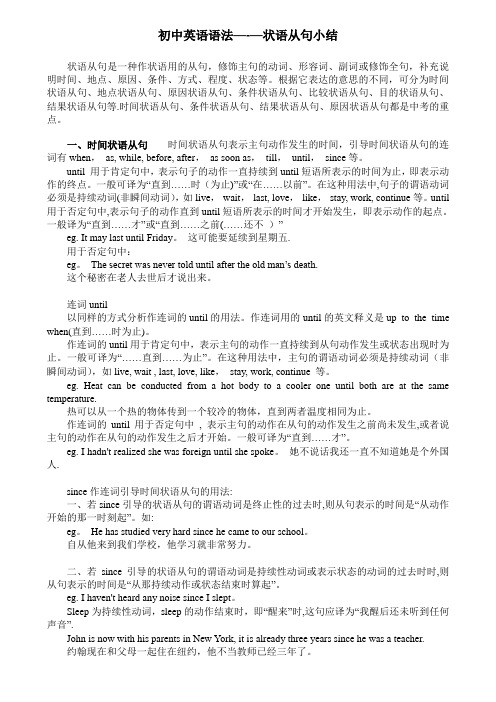
初中英语语法—-—状语从句小结状语从句是一种作状语用的从句,修饰主句的动词、形容词、副词或修饰全句,补充说明时间、地点、原因、条件、方式、程度、状态等。
根据它表达的意思的不同,可分为时间状语从句、地点状语从句、原因状语从句、条件状语从句、比较状语从句、目的状语从句、结果状语从句等.时间状语从句、条件状语从句、结果状语从句、原因状语从句都是中考的重点。
一、时间状语从句时间状语从句表示主句动作发生的时间,引导时间状语从句的连词有when,as, while, before, after,as soon as,till,until,since等。
until 用于肯定句中,表示句子的动作一直持续到until短语所表示的时间为止,即表示动作的终点。
一般可译为“直到……时(为止)”或“在……以前”。
在这种用法中,句子的谓语动词必须是持续动词(非瞬间动词),如live,wait,last, love,like,stay, work, continue等。
until 用于否定句中,表示句子的动作直到until短语所表示的时间才开始发生,即表示动作的起点。
一般译为“直到……才”或“直到……之前(……还不)”eg. It may last until Friday。
这可能要延续到星期五.用于否定句中:eg。
The secret was never told until after the old man’s death.这个秘密在老人去世后才说出来。
连词until以同样的方式分析作连词的until的用法。
作连词用的until的英文释义是up to the time when(直到……时为止)。
作连词的until用于肯定句中,表示主句的动作一直持续到从句动作发生或状态出现时为止。
一般可译为“……直到……为止”。
在这种用法中,主句的谓语动词必须是持续动词(非瞬间动词),如live, wait , last, love, like,stay, work, continue 等。
英语语法讲解之状语从句
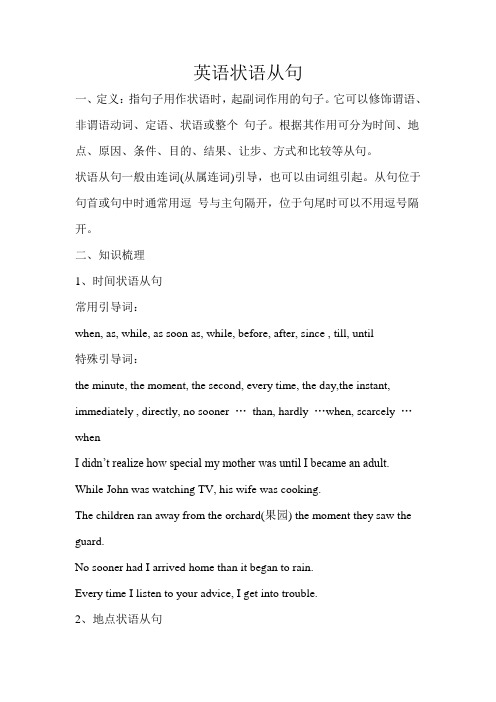
英语状语从句一、定义:指句子用作状语时,起副词作用的句子。
它可以修饰谓语、非谓语动词、定语、状语或整个句子。
根据其作用可分为时间、地点、原因、条件、目的、结果、让步、方式和比较等从句。
状语从句一般由连词(从属连词)引导,也可以由词组引起。
从句位于句首或句中时通常用逗号与主句隔开,位于句尾时可以不用逗号隔开。
二、知识梳理1、时间状语从句常用引导词:when, as, while, as soon as, while, before, after, since , till, until特殊引导词:the minute, the moment, the second, every time, the day,the instant, immediately , directly, no sooner …than, hardly …when, scarcely …whenI didn’t realize how special my mother was until I became an adult. While John was watching TV, his wife was cooking.The children ran away from the orchard(果园) the moment they saw the guard.No sooner had I arrived home than it began to rain.Every time I listen to your advice, I get into trouble.2、地点状语从句常用引导词:where特殊引导词:wherever, anywhere, everywhereGenerally, air will be heavily polluted where there are factories. Wherever you go, you should work hard.3、原因状语从句常用引导词:because, since, as, for特殊引导词:seeing that, now that, in that, considering that, given that, considering that, as much as, so much asMy friends dislike me because I’m handsome and successful.Now that everybody has come, let’s begin our conference.The higher income tax is harmful in that it may discourage people from trying to earn more.Considering that he is no more than 12 years old, his height of 1.80 m is quite remarkable.4、目的状语从句常用引导词:so that, in order that特殊引导词:lest, in case, for fear that,in the hope that, for the purpose that, to the end thatThe boss asked the secretary to hurry up with the letters so that he could sign them.The teacher raised his voice on purpose that the students in the back could hear more clearly.5、结果状语从句常用引导词:so that, so…that, such …that,特殊引导词:such that, to the degree that, to the extent that, to such a degree that,He got up so early that he caught the first bus.It’s such a good chance that we must not miss it.To such an degree was he excited that he couldn’t sleep last night.6、条件状语从句常用引导词:if, unless,特殊引导词:as/so long as, only if, providing/provided that, suppose that, in case that, on condition thatWe’ll start our project if the president agrees.You will certainly succeed so long as you keep on trying.Provided that there is no opposition, we shall hold the meeting here.7、让步状语从句常用引导词:though, although, even if, even though特殊引导词:as(用在让步状语从句中必须要倒装),while ( 一般用在句首),no matter …, in spite of the fact that, while, whatever, whoever, wherever, whenever, however, whicheverMuch as I respect hi m, I can’t agree to his proposal.尽管我很尊敬他, 我却不同意他的建议。
高中英语语法专题系列:状语从句

2)while
while侧重主句的动作发生在从句的时间之间,且从句的动 词必须是持续性的。 while+持续性动词 While we were chatting ,she was looking at the time table on the wall. While I slept, a thief broke in.
3)as
as表示 一边…一边…,强调从句和主句中两个动作交 替进行或同步进行。 Sometimes I watch TV as I am having breakfast.(一边...一边...) as表示随着,此用法不用when或while替 As spring warms the earth, all flowers begin to bloom. (随着)
状语从句定义
在复合句中担任状语成分的从句称为状语 从句,修饰主句的谓语动词,形容词或副 词等。
1. 时间状语从句
2. 地点状语从句 3. 原因状语从句
状语从句分类
4. 条件状语从句
5. 让步状语从句 6. 目的状语从句 7. 结果状语从句 8. 方式状语从句 9. 比较状语从句
1. 时间状语从句
经典例题
1. I was so familiar with him that I recognized his voice ______ I picked up the phone. A.while B. after C. In case D. the minute 答案:D 2. How long do you think it will take _______ our product becomes popular with the consumers? A.when B. until C. before D. since 答案:C
2024年人教版中考英语语法课件:状语从句知识点归纳

Wherever my sister visits, she will send me a postcard. =No matter where my sister visits, she will send me a postcard.
as
当.....时, 一边...一边...
强调主从句动作同时进行
I saw the sun as I opened the window.
1、时间状语从句
2、until/ till 引导词: ① until和till意为“直到”,很多时候可以互换,但是用于句首的时候,常用until。 Until you get back, I will sit here.
3、让步状语从句
(表示主句中的某一动作或状态与从句中的某一动作或状态在意义上有部分矛盾。) 1、although/though 引导词: although/though意为“尽管,虽然”,不与but连用,但可用yet/ still. Although/ though he works hard, yet he makes slow porgress.
③ She is such a beautiful girl that everybody loves her.
4、结果状语从句
(结果状语从句表示主句中某一动ห้องสมุดไป่ตู้或状态所产生的结果)
4、so…that… 与 such… that… 互换: 两者都意为“如此......以致于”
so+形容词+a/an+单数可数名词+that从句 人称代=s词uc是h为+a了/a避n+免我形重们容复、词,他+用们单来/数代她可替们数前/名面它词提们到”+等t过h代a的t词从人。句、人事称物代等词名有词人的称词、,单主复要数包以括及“你格、的我变、化他。,她/它、你们、
英语语法:五类状语从句的翻译讲解
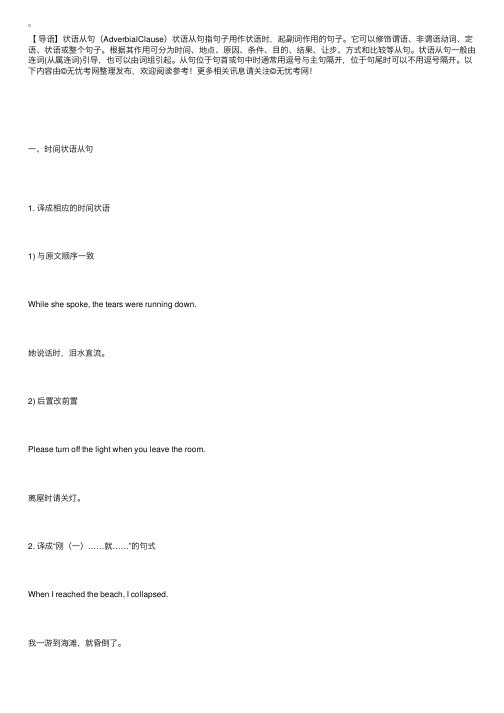
【导语】状语从句(AdverbialClause)状语从句指句⼦⽤作状语时,起副词作⽤的句⼦。
它可以修饰谓语、⾮谓语动词、定语、状语或整个句⼦。
根据其作⽤可分为时间、地点、原因、条件、⽬的、结果、让步、⽅式和⽐较等从句。
状语从句⼀般由连词(从属连词)引导,也可以由词组引起。
从句位于句⾸或句中时通常⽤逗号与主句隔开,位于句尾时可以不⽤逗号隔开。
以下内容由©⽆忧考⽹整理发布,欢迎阅读参考!更多相关讯息请关注©⽆忧考⽹!⼀、时间状语从句1. 译成相应的时间状语1) 与原⽂顺序⼀致While she spoke, the tears were running down.她说话时,泪⽔直流。
2) 后置改前置Please turn off the light when you leave the room.离屋时请关灯。
2. 译成“刚(⼀)……就……”的句式When I reached the beach, I collapsed.我⼀游到海滩,就昏倒了。
3. 译成并列的分句1) 译⽂前置They set him free when his ransom had not yet been paid.他还没有交赎⾦,他们就把他释放了。
2) 后置不变I was about to speak when Mr. Smith cut in.我正想讲,史密斯先⽣就插嘴了。
⼆、原因状语从句1. 译成表“因”的分句1) “因”在“果”之前The crops failed because the season was dry.因为⽓候⼲旱,作物歉收。
2) “果”在“因”之前She could get away with anything, because she looked such a baby.她能渡过任何风险,因为她看上去简直还像娃娃模样。
2. 译成因果偏正复句中的主句Pure iron is not used in industry because it is too soft.纯铁太软,所以不⽤在⼯业上。
英语语法:状 语 从 句
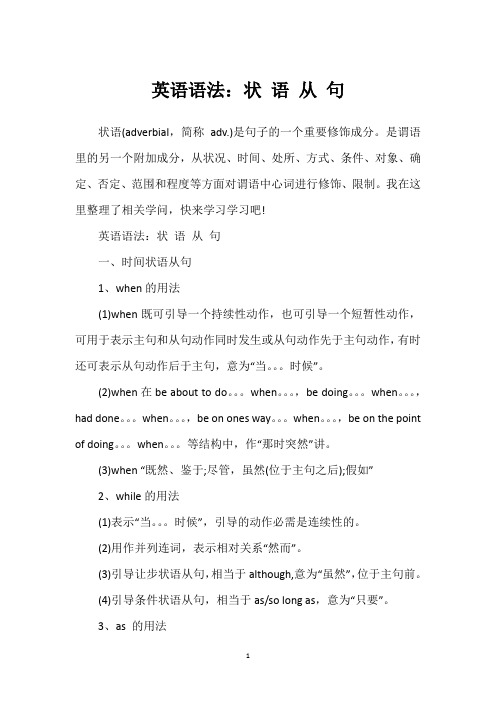
英语语法:状语从句状语(adverbial,简称adv.)是句子的一个重要修饰成分。
是谓语里的另一个附加成分,从状况、时间、处所、方式、条件、对象、确定、否定、范围和程度等方面对谓语中心词进行修饰、限制。
我在这里整理了相关学问,快来学习学习吧!英语语法:状语从句一、时间状语从句1、when的用法(1)when既可引导一个持续性动作,也可引导一个短暂性动作,可用于表示主句和从句动作同时发生或从句动作先于主句动作,有时还可表示从句动作后于主句,意为“当。
时候”。
(2)when在be about to do。
when。
,be doing。
when。
,had done。
when。
,be on ones way。
when。
,be on the point of doing。
when。
等结构中,作“那时突然”讲。
(3)when “既然、鉴于;尽管,虽然(位于主句之后);假如”2、while的用法(1)表示“当。
时候”,引导的动作必需是连续性的。
(2)用作并列连词,表示相对关系“然而”。
(3)引导让步状语从句,相当于although,意为“虽然”,位于主句前。
(4)引导条件状语从句,相当于as/so long as,意为“只要”。
3、as 的用法(1)表示“当。
时候”,强调同时发生,不指先后。
(2)说明两种正在进展或变化的状况,表示“随着”,表示时间的推移。
(3)表示“一边。
一边。
”。
(4)强调两个动作紧接着发生。
(5)表示“虽然,尽管”。
(6)其他含义“正如,正像”,“作为”,“由于,由于”。
4、before的用法(1)一般意为“在。
之前”“。
才”,“。
就”“还没有。
”“免得”“不知不觉”“宁可,宁愿”,“否则,要不然”。
(2)It + will be/was + 时间段+before+一般现在时/一般过去时。
在确定句中,意为“多长时间之后才”;在否定句中,意为“用不了多长时间就”。
5、until和till(1)与确定句连用,必需是连续性动词。
2024届高考英语一轮复习语法:状语从句课件

The dog will eat a cake as soon as the cat leaves.
主句
从句
2.地点状语从句
地点状语从句
引导词:where + 强调形式
Wherever,everywhere,anywhere 不管哪里,任何地方,所有地方
2.地点状语从句 狗狗在发现蛋糕的地方吃了它。 The dog ate the cake where he found it.
1.时间状语从句 在某一时间之中 引导词:when while as
when: 时间点,“突然”
我到家的时候,狗狗在吃蛋糕。
The dog was eating a cake when I reached home.
e:时间段
我在做饭的过程中,狗狗在吃蛋糕。
The dog was eating a cake while I was cooking.
She is as beautiful as Snow White. 她和白雪公主一样漂亮.
3.比较状语从句
比较状语从句:更…
He is smarter than I. He is smarter than l am.
This cake is bigger than that one. This cake is bigger than that one is.
Because > since > as
因果/语气
原 因
because > since > as
状 语 because 引导的实实在在的因果关系
从 句
since 引导的是众所周知的事实
as 引导的是显而易见的事实
高中英语语法--状语从句

高中英语语法状语从句一、基本概念状语(副词性)副词 动词/句子(形容词/其它副词)介词短语、动词不定式、分词短语、形容词、状语从句分类时间、地点、原因、目的、结果、条件、让步、比较、方式二、分论(一)时间状语从句(1) when 引导的时间状语从句①when 引导的时间状语从句,其动词既可以是延续性动作的动词,也可以是瞬间性动作的动词,而且可以表示主句的动作和从句的动作同时发生,或者从句的动作发生在主句的动作之前。
when you apply for a job, you must present your credentials.当你申请工作时,你必须递交你的有关证件。
(同时)when the students heard the teacher’s footsteps, they all atopped talking.当学生们听到老师的脚步声时,他们都停止了讲话。
(从句动作发生在前) ② when 还可表示just then (正在那时,突然)的意思,此时其所引导的从句只放在主句之后。
be about to do …when … 正要去做某事,突然……be doing …when…正在做某事,突然……be on the point of doing …when…正在做某事,突然……We were about to start when it began to rain.我们正要动身,突然天下起雨来。
The game had hardly/scarcely/barely begun when it started raining.比赛刚刚开始就下起雨来。
(2) as引导的时间状语从句as引导的时间状语从句其动词的动作是延续性的,而且侧重表示主句和从句的动作交替或同时发生,译为“一边……,一边……”或“随着……”We were having breakfast as she was combing her hair.她梳头时我们在吃早饭。
英语语法状语从句

状态从句
—Why didn’t you come yesterday? ——你昨天为何不来? —Because I was ill. ——因为我病了。 It was because he was ill that he was absent. 他就是因为病了才缺席的。 He is absent today.This is because he is ill. 他今天没到。是因为他病了。
状态从句
【注意】 当从句主语与主句主语相同 时,可用不定式来表达相同的意思。 译:为了通过考试,他学习非常努力。 正:He studies very hard so that (=in order that) he can pass the exam. 正:He studies very hard so as to (=in order to) pass the exam.
状态从句
2.含time的短语 可引导时间状语从句的time短语有 every time,each time,(the) next time, (the) last time,by the time,the first time,any time等。 Every time I listen to music,I’ll think of it. 每当我听音乐,我就想起这事。
job.
自从失去工作后,我的情绪一直低落。 I have made great progress since I was
ill. 我自病愈以来取得了很大进步。
状态从句
二、地点状语从பைடு நூலகம் 引导地点状语从句的从属连词有where( 在……的地方)和wherever(在……的任何地 方)等。 Where I live there are plenty of trees.我 住的地方树很多。
初中全新英语语法——状语从句(共19张PPT)

The swimming pool won't be open today because t hey're making repairs.
— Why did you move to France?
—Because my father found work in Paris.
条件状语从句
(1)if引导条件状语从句
if引导条件状语从句意为如果”,表示一种假设的条 件。如:
You can leave now if you like.如果你愿意现在就 可以走了。
If you study hard, you will pass the final examination.
(2) unless引导条件状语从句
地点状语从句
1. where引导地点状语从句 where引导地点状语从句表示“......的地方”。 We live where the road crosses the river. 2.wherever引导地点状语从句 wherever引导地点状语从句意为“在......的任何(所 自)地方”。如: You can sit wherever you like. You can put the book where you like.
You should do as I told you.
You must try to hold the tool as I do.
Just as we sweep our rooms,so we should sweep backward ideas from our minds.
比较状语从句
英语语法系列复习专题十一-----状语从句、常用动词及搭配
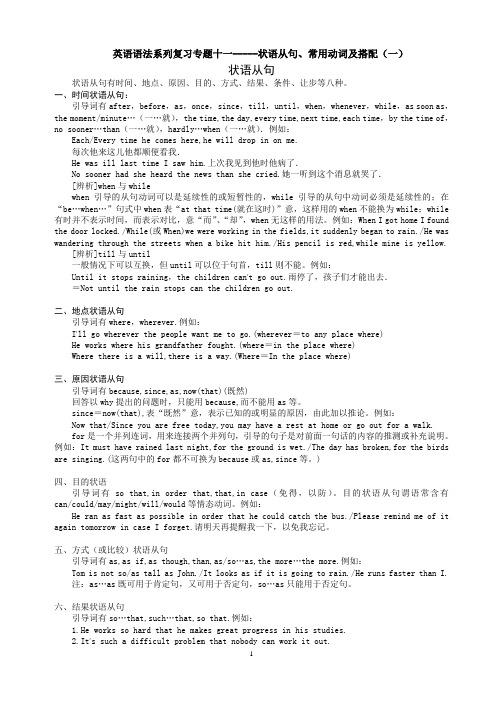
英语语法系列复习专题十一-----状语从句、常用动词及搭配(一)状语从句状语从句有时间、地点、原因、目的、方式、结果、条件、让步等八种。
一、时间状语从句:引导词有after,before,as,once,since,till,until,when,whenever,while,as soon as,the moment/minute…(一…就),the time,the day,every time,next time,each time,by the time of,no sooner…than(一…就),hardly…when(一…就).例如:Each/Every time he comes here,he will drop in on me.每次他来这儿他都顺便看我.He was ill last time I saw him.上次我见到他时他病了.No sooner had she heard the news than she cried.她一听到这个消息就哭了.[辨析]when与whilewhen引导的从句动词可以是延续性的或短暂性的,while引导的从句中动词必须是延续性的;在“be…when…”句式中when表“at that time(就在这时)”意,这样用的when不能换为while;while 有时并不表示时间,而表示对比,意“而”、“却”,when无这样的用法。
例如:When I got home I found the door locked./While(或When)we were working in the fields,it suddenly began to rain./He was wandering through the streets when a bike hit him./His pencil is red,while mine is yellow.[辨析]till与until一般情况下可以互换,但until可以位于句首,till则不能。
英语语法_状语从句

(五)Since 引导的时间状语从句: a) Since后面的动词不同,动作的起算时间不同: since+终止性动词的过去式,从该动作发生时算起; since+延续性动词的过去式,从该动作结束时算起。 It‘s three years since he joined the League. 他入团三年了。 It is three years since he smoked. 他戒烟三年了。 b)― It is + 一段时间+ since – clause‖ 句型。 It‘s two years since we arrived here. 我们到这儿两年了。 It was years since I had seen her. 我认识她好几年了。
时间状语从句的引导词:
when, while, as, before, since, until, till, as soon as, once, hardly…when, no sooner…than ,whenever, after ,等 • 主句是将来时,时间状语从句和条件状语 从句用一般现在时表示将来的动作,即: 主将从现。
原因状语从句
• 原因状语从句:由because, since, now that, as, for 引导。 • 1.because 语气最强,用来回答why提问,可用在强调 句型中。 • I do it because I want to do it. • It was because he was ill that he didn‘t go with us. • 2.Since语气比because弱,表示关系上的自然结果, 一般译成“既然,鉴于”(往往放于主句之前) • Since you‘re free today, let‘s go to the cinema. • 3.as语气最弱,只说明一般的因果关系(可放于主句之 前,也可放于主句之后) • Wear strong shoes as we shall do a lot of walking today.
英语语法——从句部分
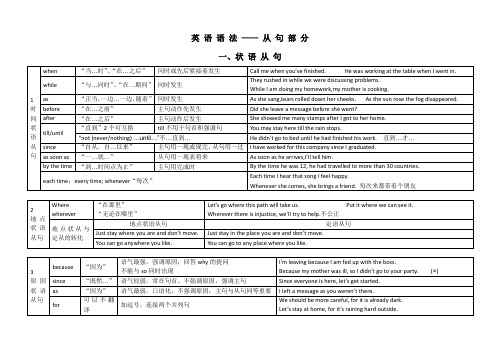
You can go anywhere you like.
You can go to any place where you like.
3
原因状语从句
because
“因为”
语气最强,强调原因,回答why的提问
each time;every time; whenever“每次”
Each time I hear that song I feel happy.
Whenever she comes, she brings a friend.每次来都带着个朋友
2
地点状语从句
Where
wherever
“在那里”
“无论在哪里”
如果从句是否定句,可与too…to互换
They were so tired that they couldn’t go any farther.
= They were too tired to go any farther.
such…that…
such +a/an +adj+ cn单数+that从句
You’d better travel around NanJing with a local tour guideifyou want to know more about its culture.
若从句正在进行或将来可以实现,从句用进行时或现在完成时,主句用将来时
I’ll show you how to do it if I have finished the book.
so +many/few +cn +that从句
- 1、下载文档前请自行甄别文档内容的完整性,平台不提供额外的编辑、内容补充、找答案等附加服务。
- 2、"仅部分预览"的文档,不可在线预览部分如存在完整性等问题,可反馈申请退款(可完整预览的文档不适用该条件!)。
- 3、如文档侵犯您的权益,请联系客服反馈,我们会尽快为您处理(人工客服工作时间:9:00-18:30)。
全新英语语法—状语从句用一个句子作状语,这个句子就是状语从句。
状语从句通常用来修饰句子、动词或形容词,表示时间、地点、条件、原因、目的、结果、方式、比较等。
引导状语从句的连词叫从属连词。
16-1 时间状语从句在句中相当于时间状语的从句叫时间状语从句。
时间状语从句常由从属连词when,while,as,before,after,as soon as,since,till,until等引导。
如:What are you going to be when you grow up?I will phone you as soon as I get there.1.引导时间状语从句的从属连词及用法(1)when,while,as引导时间状语从句意为“当......时”。
如:When the clock struck twelve, all the lights went out.While Peter was reading,his wife was cooking.He dropped the glass as he stood up.(2)before引导时间状语意为“在......之前”。
如:Don't jump off the train before it stops.Look at both ways before you cross the road.I didn't know any English before I came here.(3)after引导时间状语从句意为“....之后”。
如:I'll have a walk after I finish my work.After he locked the door, he left.(4) until,till引导时间状语从句意为“直到......为止”。
如:They waited till/until I returned.Mr. Wang kept on explaining until the student understood.(5) since引导时间状语从句意为“自......以来”Since I left school, I have written to him twice.I have not heard from him since he left Shanghai.(6)as soon as引导时间状语从句意为“一.......就.......”I'll tell you as soon as I get here.I want to see him as soon as he arrives.2.时间状语从句的时态(1) 当主句的谓语动词是一般将来时,由when,before,after ,as soon as,until等连词引导的时间状语从句用一般现在时。
如:I ’ll tell him the good news as soon as I see him.The boy will be a writer when he grows up.(2)主句的训语含有Can,may,must等情态动词时,由when,before,after,until,as soon as 等引导的时间状语从句用一般现在时。
如:You can go home after you finish your homework.When the lights are red, the traffic must stop.You may wait here before your father comes.(3)当主句的谓语是want, hope, wish等动词的一般现在时形式时,由when,before,after, until,as soon as等引导的时间状语从句用一般现在时,如:He wants to be a doctor when he grows up.She wants to work in America when she finishes college.(4)当主句是祈使句时,由when, before, after, until等引导的时间状语从句用一般现在时。
如:Don't get off the bus until it stops.Please don't go to bed before you finish your homework.(5)当主句谓语用一般过去时,由when. before, after, until, as soon as等引导的时间状语从句也要用一般过去时。
如:They talked about the party after people left.(6)当before引导的时间状语从句是过去时态,主句一般用过去完成时,有时也用一般过去时。
如:She had learned Japanese for three years before she went to Japan.She didn't know me before she came here.(7) since引导的时间状语从句要用一般过去时,主句的谓语动词要用延续性动词,通常用现在完成时;用非延续性动词时,要用否定式。
如:He has waited here since you left.He hasn't gone to the school since he finished the school.3.时间状语从句的位置(1) when, before, after, as, while, as soon as等引导的时间状语从句的位置可位于句首,也可位于句末。
放在句首时,从句后通常用逗号与主句隔开,放在句末时,从句与主句之间一般不用逗号,只在句末用句号或问号。
如:When you came to see me, I was ready to leave.You called me while I was watching TV.After she cleaned the classroom, she went home.(2)since引起的时间状语从句通常放在主句的后面。
I have learned English since I came to this school.16-2 地点状语从句在句中表示地点的状语从句称为地点状语从句。
引导地点状语从句的从属连词有where,wherever。
1. where引导地点状语从句where引导地点状语从句表示“......的地方”。
如:We live where the road crosses the river.2.wherever引导地点状语从句wherever引导地点状语从句意为“在......的任何(所自)地方”。
如:You can sit wherever you like.You can put the book where you like.16-3条件状语从句在句中表示条件的从句叫条件状语从句。
条件状语从句常用if和unless引导。
1.条件状语从句的引导词及用法(1)if引导条件状语从句if引导条件状语从句意为如果”,表示一种假设的条件。
如:You can leave now if you like.如果你愿意现在就可以走了。
If you study hard, you will pass the final examination.(2) unless引导条件状语从句unless引导条件状语从句意为“除非;如果不...”相当于if ... not,而且可以与if引导的条件状语从句互换使用。
如:I will go there tomorrow unless it rains.=I will go there tomorrow if it doesn't rain.(3) so/as long as引导条件状语从句so long as或as long as引导条件状语从句意为“只......如:So/As long as you promise to go, I'll surely go.2.条件状语从句的时态(1)当主句的谓语动词是一般将来时,条件状语从句用一般现在时。
如:I'll say at home if it rains tomorrow.(2) 当主句的谓语含有can, may, must 等情态动词时,条件状语从句用一般现在时。
如:You may watch TV if you finish your homework.(3) 当主句是祈使句时,条件状语从句用一般现在时。
如:Don't play unless you finish your work.3. 条件状语从句的位置条件状语从句可位于句首,也可位于句末。
放在句首时,从句后通常用逗号与主句隔开,读时用升调;放在句末时,从句与主句之间一般不用逗号,只在句末用句号或间号,读时用降调。
如:If it doesn't rain tomorrow, Ill bring you to the park.He will go to play the game unless he is ill tomorrow.16-4原因状语从句在句中表示原因的状语从句叫原因状语从句。
引导原因状语从句的从属连词主要有because, as, since, for, now that等。
如:Ido it because I like it.As it was raining, I stayed at home.Since you're not interested, I won't tell you about it.Let's stay at home, for it's raining hard outside.Now that you are well again, you can travel.1.引导原因状语从句的从属连词及用法because, as, since, for, now that 作从属连词引导原因状语从句都表示“因为”,其用法区别是:(1) because意为“因为”,与as, for, since相比语气最强,主从句间有直接的因果关系,它所指的原因通常是听话人所不知道的;从句一般放在主句的后面,也可放在主句前面或单独存在;在回答why的问句时,只用because。
如:He is absent, because he is ill.(“生病”是“缺席”的必然原因)The swimming pool won't be open today because they're making repairs.— Why did you move to France?—Because my father found work in Paris.(2)as意为“因为;由于”,语气比because, since弱,含义与since相同,但没有since正式;所引导的原因状语从句表示不言而喻、为人所知、显而易见的原因和理由,或者理由不是很重要;as 引导的从句通常位于主句的前面;从句说明原因,主句说明结果,主从并重。
